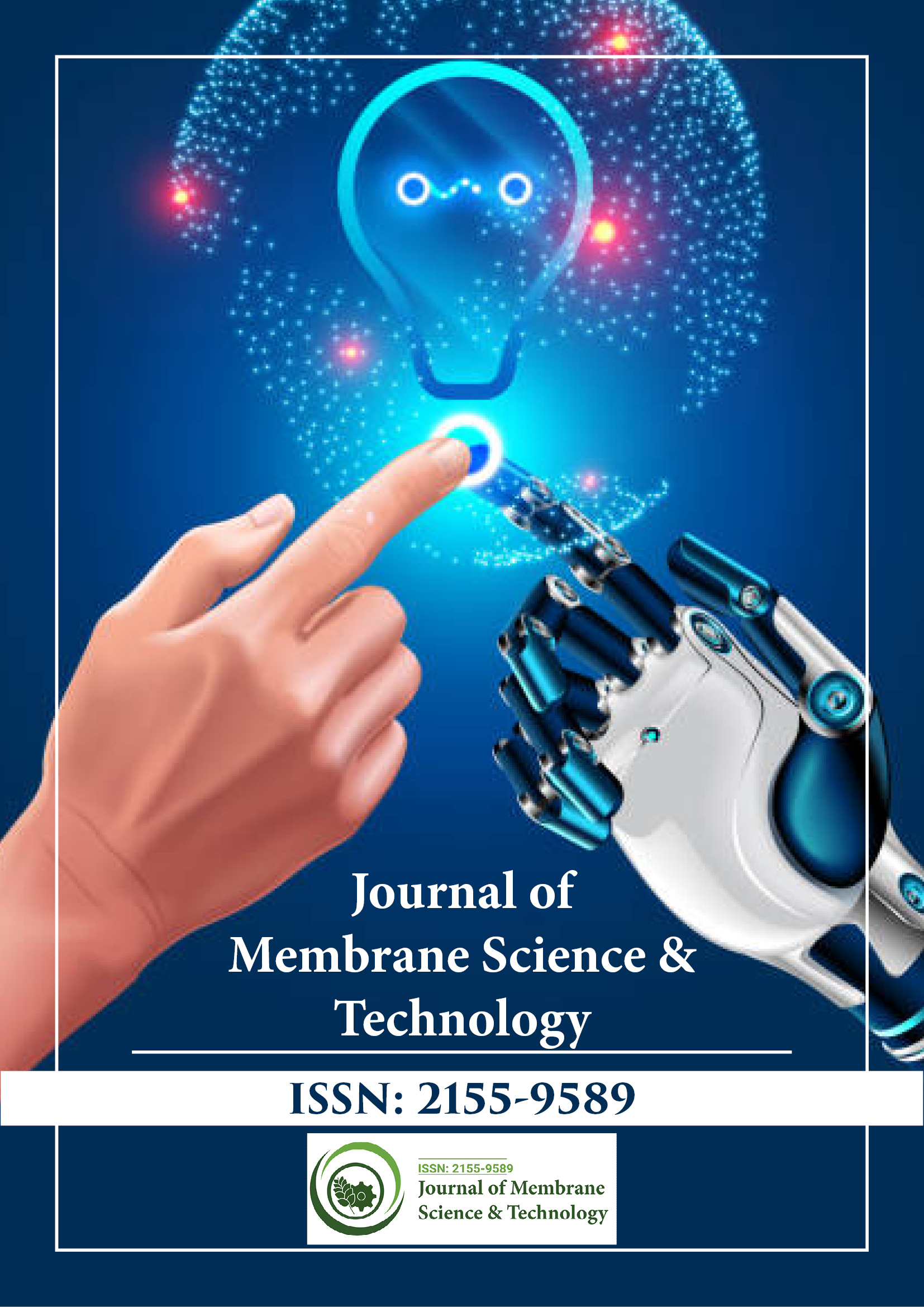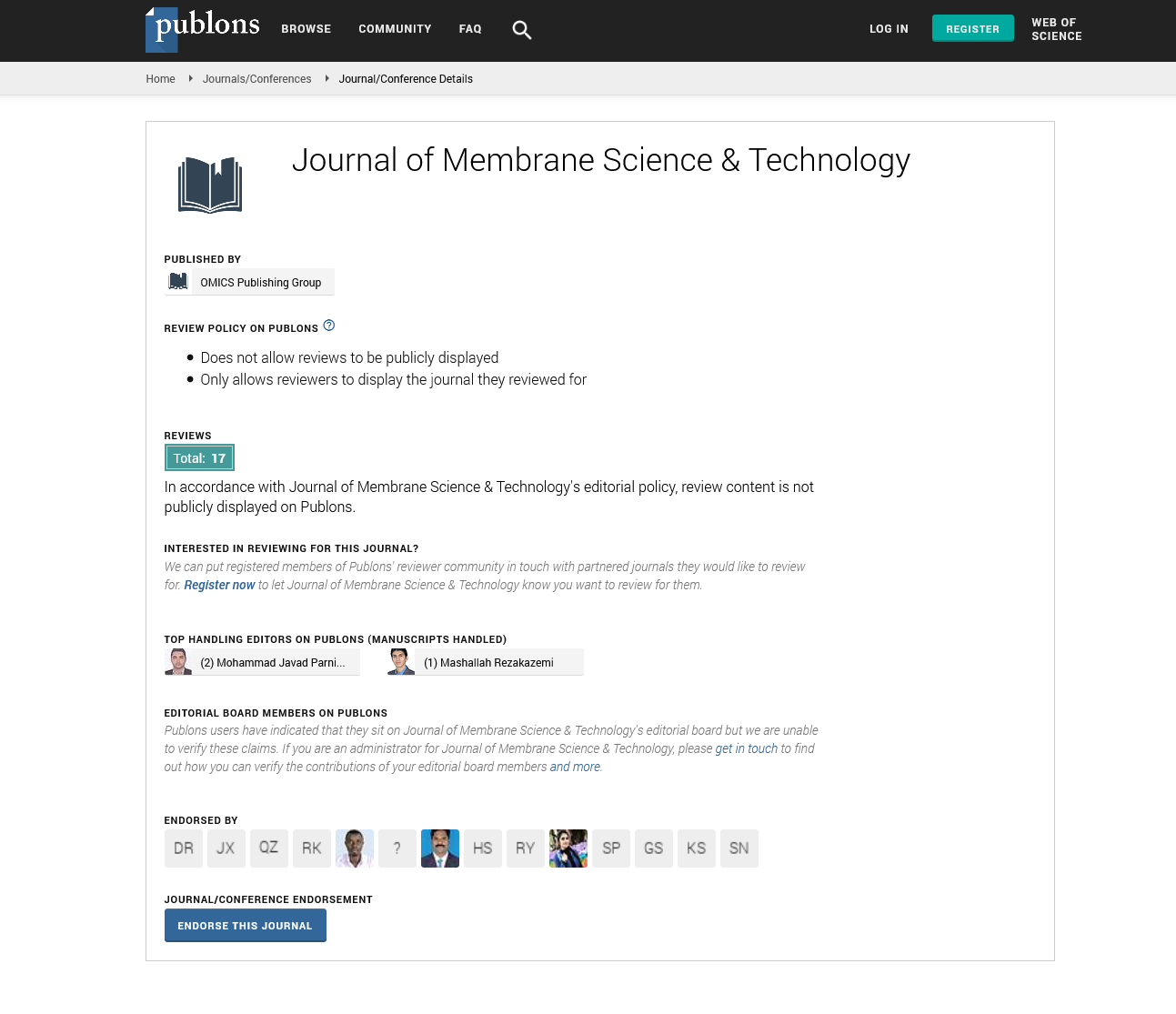Indexed In
- Open J Gate
- Genamics JournalSeek
- Ulrich's Periodicals Directory
- RefSeek
- Directory of Research Journal Indexing (DRJI)
- Hamdard University
- EBSCO A-Z
- OCLC- WorldCat
- Proquest Summons
- Scholarsteer
- Publons
- Geneva Foundation for Medical Education and Research
- Euro Pub
- Google Scholar
Useful Links
Share This Page
Journal Flyer

Open Access Journals
- Agri and Aquaculture
- Biochemistry
- Bioinformatics & Systems Biology
- Business & Management
- Chemistry
- Clinical Sciences
- Engineering
- Food & Nutrition
- General Science
- Genetics & Molecular Biology
- Immunology & Microbiology
- Medical Sciences
- Neuroscience & Psychology
- Nursing & Health Care
- Pharmaceutical Sciences
Short Communication - (2025) Volume 15, Issue 2
Innovative Advances in Membrane Materials for Modern Filtration and Separation Technologies
Jorg Mussig*Received: 30-Apr-2025, Manuscript No. JMST-25-29437; Editor assigned: 02-May-2025, Pre QC No. JMST-25-29437; Reviewed: 16-May-2025, QC No. JMST-25-29437; Revised: 23-May-2025, Manuscript No. JMST-25-29437; Published: 30-May-2025, DOI: 10.35248/2155-9589.25.15.419
Description
Membrane materials have become fundamental components in a wide array of industries, particularly those involving filtration, separation and purification. As the global demand for cleaner water, purer chemicals and more sustainable industrial practices continues to grow, the importance of developing advanced membrane materials is greater than ever. These membranes, functioning as selective barriers, are pivotal in applications such as water desalination, wastewater treatment gas separation, food processing and biomedical devices. Their performance is typically judged by selectivity, permeability, mechanical strength, thermal stability and resistance to fouling or chemical degradation.
Traditionally, membranes were made from simple polymeric materials such as cellulose acetate or polysulfone, which provided modest performance for early applications. However, the limitations of these early membranes spurred the development of more sophisticated materials that could meet modern demands. Over the past few decades, significant strides have been made in tailoring membrane materials for specific purposes. The introduction of Thin-Film Composite (TFC) membranes marked one of the most important milestones. TFC membranes typically consist of a highly selective polyamide thin film formed on a porous support layer. This configuration offers a high degree of selectivity and flux, making them the industry standard for Reverse Osmosis (RO) and Nanofiltration (NF) processes [1].
More recently, nanotechnology has played a transformative role in enhancing membrane properties. The incorporation of nanomaterials such as carbon nanotubes, graphene oxide and Metal-Organic Frameworks (MOFs) into membrane matrices has led to the creation of nanocomposite membranes with superior performance characteristics. These nanomaterials can increase water flux, improve mechanical strength and impart antimicrobial or anti-fouling properties. For example, membranes embedded with silver nanoparticles can effectively inhibit bacterial growth, reducing biofouling and extending operational life [2].
Another major advancement in membrane technology involves the use of block copolymers and other advanced polymers with precisely controlled morphologies. These materials allow the creation of membranes with uniform pore sizes and higher structural integrity. Some block copolymer membranes can even self-assemble into desired nanostructures, providing highly tunable performance characteristics suitable for specialized separations, such as the removal of specific ions or biomolecules [3, 4].
Inorganic membranes represent another category that has garnered attention for their excellent thermal and chemical stability. Made from materials such as ceramics, silica, or zeolites, these membranes are especially useful in harsh environments, such as high-temperature gas separations or aggressive solvent filtration. Ceramic membranes, for instance, offer long operational life and can be regenerated through thermal or chemical cleaning. However, their high manufacturing cost remains a limitation for widespread adoption [5].
Hybrid membranes, which combine both organic and inorganic components, aim to strike a balance between performance and cost. These membranes often leverage the flexibility of polymers with the durability of ceramics or the unique properties of nanomaterials. For example, polymer-ceramic composites can provide both high permeability and robust mechanical properties, suitable for complex industrial processes [6].
Environmental sustainability is another critical consideration in the development of modern membrane materials. There is growing interest in creating biodegradable or recyclable membranes, as well as those derived from renewable resources. Membranes made from biopolymers such as chitosan, alginate and Polylactic Acid (PLA) have been explored for their eco-friendly characteristics. While these materials may not yet match the performance of synthetic polymers in all applications, they represent an important step toward greener membrane technologies [7].
In addition, the problem of membrane fouling where particles, microbes, or chemical deposits accumulate on membrane surfaces remains a significant operational challenge. Fouling not only reduces membrane efficiency but also increases maintenance costs and energy consumption. As a result, anti-fouling membrane materials have become a major focus of research. Surface modifications, such as hydrophilic coatings or zwitterionic functional groups, can repel contaminants and reduce the frequency of cleaning. Stimuli-responsive membranes, which change their surface properties in response to temperature, pH, or other environmental conditions, are also being developed to self-clean or switch functions during operation [8].
The future of membrane materials lies in the synergy of advanced materials science, computational modeling and process engineering. Artificial intelligence and machine learning are beginning to assist in the design of next-generation membranes by predicting material performance before synthesis. These data-driven approaches can accelerate innovation while reducing trial-and-error experimentation [9].
Ultimately, the evolution of membrane materials is enabling more efficient, sustainable and specialized separation processes across industries. Whether addressing global water scarcity, improving pharmaceutical purity, or capturing greenhouse gases, the role of membranes and the materials they’re made from is more critical than ever. With continued research and interdisciplinary collaboration, membrane technologies are poised to play a central role in solving some of the most pressing environmental and industrial challenges of our time [10].
Conclusion
Ultimately, the evolution of membrane materials is enabling more efficient, sustainable and specialized separation processes across industries. Whether addressing global water scarcity, improving pharmaceutical purity, or capturing greenhouse gases, the role of membranes and the materials they’re made from is more critical than ever. With continued research and interdisciplinary collaboration, membrane technologies are poised to play a central role in solving some of the most pressing environmental and industrial challenges of our time.
References
- Basile A, Cassano A, Rastogi NK, editors. Advances in membrane technologies for water treatment: materials, processes and applications. Elsevier. 2015.
- Sirkar KK. Membrane separation technologies: Current developments. Chem Eng Commun. 1997;157(1):145-84.
- Sahu LR, Yadav D, Borah D, Gogoi A, Goswami S. Polymeric membranes for liquid separation: Innovations in materials, fabrication and industrial applications. Polymers. 2024;16(23):3240.
[Crossref] [Google Scholar] [PubMed]
- Kafle SR, Adhikari S, Shrestha R, Ban S, Khatiwada G. Advancement of membrane separation technology for organic pollutant removal. Water Sci Technol. 2024;89(9):2290-310.
[Crossref] [Google Scholar] [PubMed]
- Hussain A, Janson A, Matar JM, Adham S. Membrane distillation: Recent technological developments and advancements in membrane materials. Emergent Mater. 2022;5(2):347-67.
- Khan N, Tabasi ZA, Liu J, Zhang BH, Zhao Y. Recent advances in functional materials for wastewater treatment: from materials to technological innovations. J Marine Sci Eng. 2022;10(4):534.
- Senusi F, Shahadat M, Ismail S, Hamid SA. Recent advancement in membrane technology for water purification. Mod Age Environ. 2017:147-67.
- Singh R, Ahn YH. Separation science in modern era. 1st edition. J Sep Sci; 2025.
- Bera SP, Godhaniya M, Kothari C. Emerging and advanced membrane technology for wastewater treatment: A review. J Basic Microbiol. 2022;62(3-4):245-59.
[Crossref] [Google Scholar] [PubMed]
- Osman AI, Chen Z, Elgarahy AM, Farghali M, Mohamed IM. Membrane technology for energy saving: principles, techniques, applications, challenges and prospects. Adv Res. 2024;5(5):2400011.
Citation: Mussig J (2025) Innovative Advances in Membrane Materials for Modern Filtration and Separation Technologies. J Membr Sci Technol. 15:419.
Copyright: © 2025 Mussig J. This is an open-access article distributed under the terms of the Creative Commons Attribution License, which permits unrestricted use, distribution and reproduction in any medium, provided the original author and source are credited.

